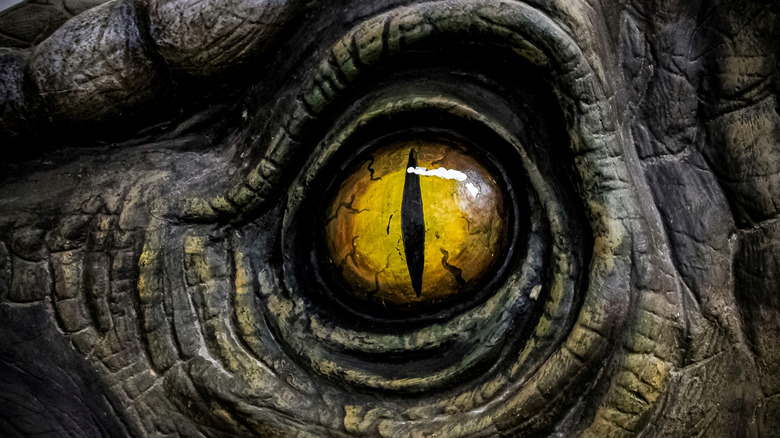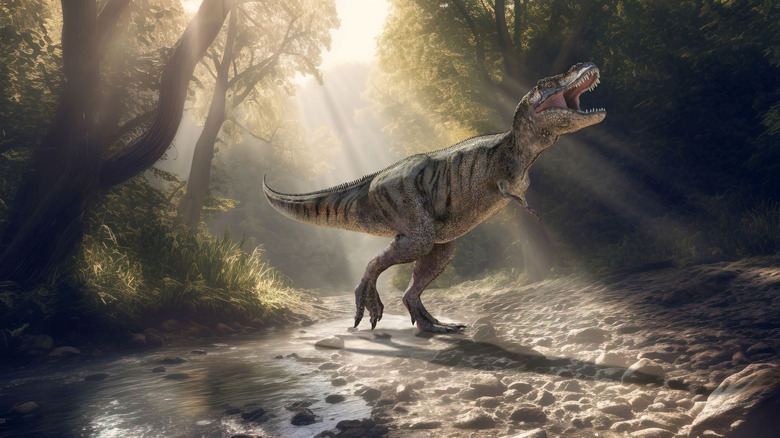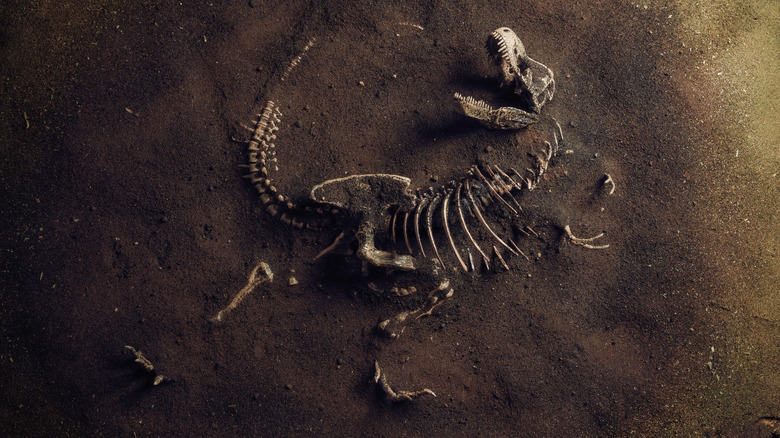The T. Rex Would Be Nothing Without A Dinosaur You've Never Heard Of
Everybody knows the name Tyrannosaurus rex. The most famous dinosaur to ever walk the Earth has been made iconic by movies like "The Lost World" and "Jurassic Park," but through its notoriety, it has come to overshadow the rest of its family tree. Still, scientists have been trying to untangle the mysteries of that lineage, and they've stumbled upon some new informatin
In June of 2025, a research team led by paleontologists at the University of Calgary announced the discovery of a new dinosaur species in the journal Nature. The species' fossils had been sitting in a Mongolian museum for four decades, but were found to have been improperly classified, leading to the realization that they came from a never-before-described dinosaur. The new find has been named Khankhuuluu mongoliensis (khan-KOO-loo), meaning "dragon prince of Mongolia," and while every dinosaur discovery is exciting, this one could be truly revolutionary. Khankhuuluu isn't just any old lizard: it's the closest known ancestor of all tyrannosaur species, including T. rex.
For reference, T. rex belongs to the family Tyrannosauridae, also known as the tyrannosaurs, which includes other large carnivores like Albertosaurus, Gorgosaurus, and Tarborsaurus. These genera all share similar skeletons, suggesting that they probably had a similar appearance to a T. rex. They also all lived around the same time, during the Late Cretaceous, which was the last of the time periods in which the dinosaurs dominated Earth. They arose pretty late in the dinosaur timeline, making their lineage a puzzle for paleontologists, and now, Khankhuuluu is reshaping everything we thought we knew about their lineage.
Where Khankhuuluu fits in the tyrannosaur family tree
Tyrannosaurs belong to a larger clade of dinosaurs called Tyrannosauroidea, or the tyrannosauroids. K. mongoliensis is not in the tyrannosaur family, but is rather an older member of the tyrannosauroid clade, making it a predecessor to tyrannosaurs. Paleontologists have dated the species to roughly 86 million years ago, making it about 10–20 million years older than the giant tyrannosaurs like T. rex and Tarborsaurus. Khankhuuluu isn't the oldest tyrannosauroid we know of, with the clade having originated in the Middle Jurassic epoch. However, the newly-discovered species fills a longstanding and critical gap in the fossil record, right at the point when tyrannosauroids ascended to apex predator status.
Nearly all dinosaur species followed a timeline wherein their members grew larger with time, so it stood to reason that the giant tyrannosaurs of the Late Cretaceous descended from something much smaller. Khankhuuluu was a fairly large animal by human standards, being 13 feet long and likely weighing around 1,650 pounds, but it pales in comparison to Tyrannosaurus, which could top 13,000 pounds. Khankhuuluu has a few other features that also hint at its more primitive role in the tyrannosauroid line. Its jaws were shallower than a T. rex's, which would have given it a weaker bite force, and the bones around its snout and eyes are slightly different in structure. However, one iconic characteristic it did share with its descendents was a set of tiny T. rex arms.
Khankhuuluu rewrites our knowledge of dinosaur migrations
The discovery of K. mongoliensis has upended our knowledge of the T. rex's lineage not just because of its biology, but also where it was found. Fossils of various tyrannosaur species have been uncovered in both North America and Asia, but exactly how the family dispersed across two different continents has been a mystery. During the time of T. rex, the western portion of present-day North America was part of a different continent called Laramidia, which was connected to nascent Asia via the Bering Strait land bridge. Researchers believe that Khankhuuluu may have been the first tyrannosaurid to cross this bridge, bringing the lineage to Laramidia from its origin point in Asia.
The new find is also changing our knowledge of the tyrannosaur timeline. They likely evolved over not one, but two separate periods of intercontinental migration. The first took place around the time of Khankhuuluu, but around 78 million years ago, a group of tyrannosaurs crossed back into Asia. These diversified into two groups: one that was small and had horns, and one which grew larger and developed bone-crushing jaws. Members of this larger group then made another migration back to North America, where T. rex finally evolved. This paints a much more nuanced picture of the tyrannosaur family, and will likely draw more interest in the study of tyrannosaurs in Asia, which was not considered as significant in their development until now.


